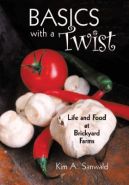It’s been a few weeks since I’ve sat down to do a blog post. Late spring is an impossibly busy time for us. We are nearing the completion of planting crops, going to market 3 times a week, along with managing watering, weeding and harvesting. In spite of it all we still enjoy our evening cocktail, great food, good friends and rousing games of dominoes!
Three years ago we had a thriving bee hive that was essential for pollinating our 5.5 acre vegetable truck farm. Without our bees, our vegetable production is noticeably smaller per acre. We, like many amateur and commercial bee keepers have experienced CCD or Colony Collapse Disorder. Studies have shown that CCD is possibly the result of environmental stressors, such as an excess of cold and damp weather. This along with overuse of pesticides to control mites, has resulted in pesticide poisoning. In addition, exposure to GMO crops have affected the honeybee population in unimaginable ways. In an effort to bend nature to our will to produce larger yields of commercial honey, we may just have endorsed an environment that will lead to the destruction of beekeeping as we know it.
Many small-scale beekeepers looked for a more natural and self-sustainable way to keep bees that not only benefited us, but put the bee and its needs ahead of the harvesting of the bees cherished product: honey. This turned out to be the top-bar hive. Originally developed by Abbe Warre (1876-1951) a Frenchman who after experimenting with over 350 hives of various designs and types, came up with the People’s Hive. His goal was to find a hive system that was simple, natural, economical, and bee-friendly.
It is our good fortune to have a friend who is not only interested in having his own top-bar hives, but was willing to build and manage one for us as well. Dennis, who I’ll describe as a brilliant eccentric, has embraced his new hives with a passion to match his intellect. He and his wife Julie live largely off the grid and off their land. Beekeeping was a natural extension of this lifestyle. Learning from Dennis about our new hive is an ongoing adventure.
Dennis’ approach to his hives has some simple rules:
- Interference in the natural lives of the bees is kept to a minimum.
- Nothing is put into the hive that is known to be, or likely to be harmful either to the bees, to us or to the wider environment and nothing is taken out that the bees cannot afford to lose.
- The bees know what they are doing; our job is to listen to them and provide the optimum conditions for their well-being.
Some of the features of our hive are as follows:
- The hive-body box internal dimensions are 300 x 300 x 210 mm, with projecting handles
- There are eight 36mm centered 24mm wide top-bars resting in rebates in each box
- Wax starter strips are under each top bar (NO FOUNDATION)
- Flat floor, notched with 120mm wide entrance, alighting board
- Coarse weave cloth covering the top-bars of the top box
- 100 mm high ‘quilt’ boxed with wood, filled with straw, sawdust, wood shaving etc., retained with cloth
- Gabled roof containing a ventilated ‘loft’ and separated from the quilt by a mouse-proof board
- New boxes are added at the bottom
Dennis, being Dennis also added little peak windows of plexiglass covered by small shutters that allow us to observe the interior of the hive without disturbing the bees. So far the new queen is happy and producing ‘brood’, and the worker bees are busy making comb and bringing pollen to the hive.
We are new to beekeeping and look forward to learning from and observing our bees. Maybe, just maybe they will be happy and content enough to bless us with some honey after a busy season of pollinating our crops and building a healthy hive.
With temperatures soaring beyond 90 for the Memorial Weekend it certainly feels like summer, without the abundance of vegetables coming off the farm. Fortunately we put up a lot of frozen corn which turned into a great summer salad (even if it’s not summer on the calendar yet!) This is great when it’s hot and you don’t want to heat up the kitchen. Serve it with anything from the grill and you’re good to go….
Summer Corn Salad:
- 2 cups fresh or frozen corn
- 1 jalapeno minced and seeded
- 1/2 cup finely chopped red onion
- 1 cup finely chopped red bell pepper
- 1/3 cup finely chopped fresh cilantro
- 1/3 cup vegetable or canola oil
- 1/4 cup fresh lime juice
- 1/2 tsp ground cumin
- Mix together first five ingredients.
- Mix together oil, lime juice and cumin. Pour over salad, toss and chill for 45 minutes.
Serves: 4-6
Additional suggestions: Serve with guacamole and chips for a fast lunch. Use as a filling for quesadillas. Use as a filling for a frittata. Yum
“I dreamt — marvellous error! — that I had a beehive here inside my heart. And the golden bees were making white combs and sweet honey from my old failures.”
― Antonio Machado









Pingback: Summer Corn Salad |
So happy to inspire you to expand on a good idea! Looks great!
I just copied this recipe down. It sounds wonderful … all the ingredients I love. The corn, although it is not local, has been outstanding this year.
You guys are awesome! Thanks again for the plants!
Our pleasure!
LOVE this post and the Machado quote! (I put it on my Facebook page today.) Y’all are inspiring me to think again about keeping bees… technically they are not “legal” in our city limits, but…. Thanks!
HI Amy! It’s so important to affirm support for these creatures that are so very important to our food supply. I too love the Machado quote. Thanks so much! Kim